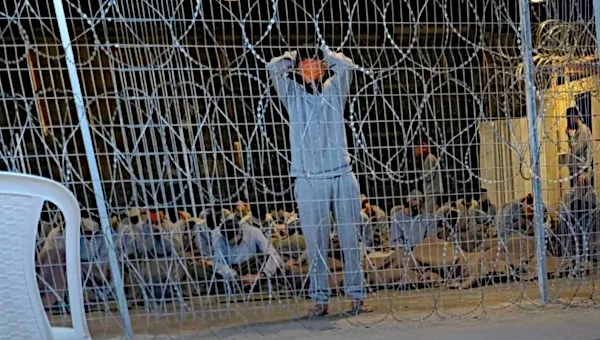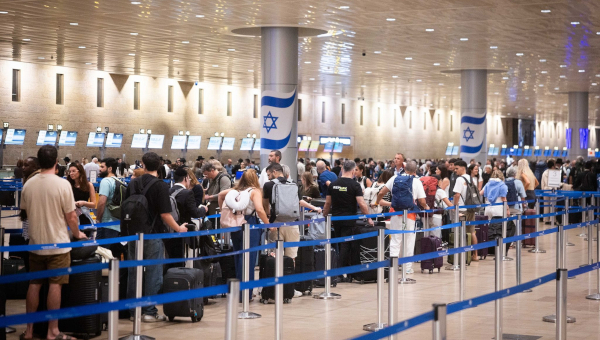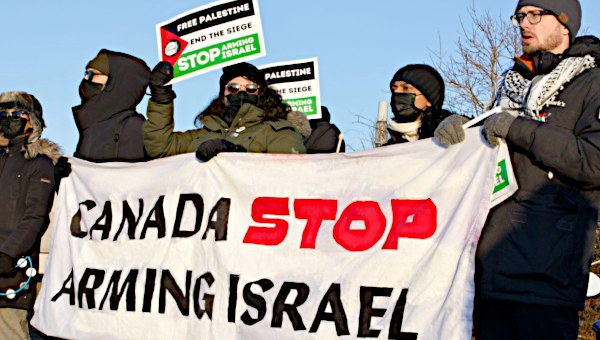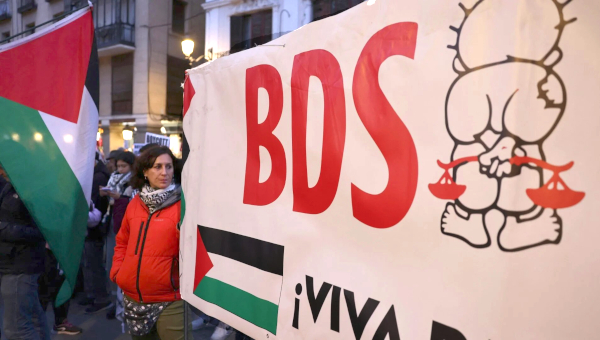Sde Teiman Camp: Israel’s ‘Guantanamo’
The Israeli occupation authorities acknowledged early last month [June/24] the martyrdom, in the Sde Teiman camp, of 36 detainees from the Gaza Strip. These deaths demand that we focus on the grave violations that Palestinian detainees from the Gaza Strip are exposed to from the moment of arrest on the street or in their homes during ongoing military operations, to when they are subjected to field interrogation. This treatment has led to the death of dozens of detainees, either in the field or inside detention and interrogation camps, most notably the Sde Teiman camp where Gaza Strip detainees are held.
Testimonies of people recently released from this camp indicate that this is a site of brutal, systematic torture where all methods of torture are used, including electric shock, dogs, and beatings, along with continuous handcuffing. Some detainees are also transferred, after undergoing multiple and intense torture sessions, to the Anatot camp next to the town of Anata or to Ofer Prison near the city of Ramallah, where they are subjected to even more torture.

Introducing the Sde Teiman camp: “Israel’s Guantanamo”
The Sde Teiman detention centre is located on the eastern side of Juhr al-Dik, inside the Gaza envelope, in the area between the envelope and the Beersheba settlement. This camp is a military air base that the Israeli occupation authorities have converted into a detention centre for the people of the Gaza Strip. They have recently built a group of barracks there, their number estimated, according to the statements of released detainees, to be 15 large barracks, each of which can accommodate an estimated 130 to 150 detainees.
It is worth noting that work is still underway to create new barracks there to accommodate a larger number of Gaza Strip detainees, to whom the occupation authorities apply the status of illegal fighters, depriving them of all legal guarantees provided by international laws and customs.
Extreme Conditions Inside Sde Teiman Detention Centre
One of the detainees, who spent 21 days in Sde Teiman detention centre, said that the detainees there are between the ages of 18 and 70 years old. They are forced to kneel inside the barracks, with their legs and hands tied, all day long in one position in organized lines. This goes on from 6 am until 1 am, after which they are allowed to sleep on a piece of leather two centimetre (about 3/4″) thick, still in shackles or cuffs. What is known as the “Shaweesh,” or room supervisors, supervise all the detainees while they sleep and also take them to the bathroom when they are given permission to do so. Moreover, it is worth noting that none of the Gaza Strip detainees are brought before any competent judicial authorities.
According to testimonies by released detainees, those who were brought from Gaza to Sde Teiman arrive at reception barracks and are subjected to harsh torture conditions for the first week. These included continuous sitting in a specific rigid position and deprivation of sleep, after which they are transferred to another barracks (Marduan) where they are subjected to interrogation by the intelligence service.
Furthermore, one detainee reported that he was made to stand, with his hands and feet tied, and his eyes blindfolded, in a pool of water. He was kept there for five minutes while he was subjected to intense electric shock until he lost consciousness. When he awoke, he was lying on the ground in a barracks with his entire body numb. He also reported that one of the other detainees (M.T.), 28 years old, had a heart condition and the detainee witnessed M.T. martyred right in front of him after dogs were brought in to attack him. M.T.’s body was left there for half an hour until they took him out. The witness later learned that M.T. had died when his heart gave out from his terror of the dogs. The witness also reported wide use of pepper being sprayed into detainees’ faces, causing them great pain.
Failure to Provide Medical Treatment
Some of the former detainees stated that dozens of elderly prisoners in “Israel’s Guantanamo” camp have chronic diseases (e.g., diabetes, high blood pressure) but are not provided any medication. As a result, many diabetic detainees have experienced diabetic burnout attacks under conditions of severe food shortages, exposure to cold weather, and severe torture. One detainee indicated that the only medicine permitted is Acamol, but not on a regular basis. Furthermore, detainees are regularly threatened with death, including sick detainees, when they demand medicine instead of provision of treatment.
One detainee reported that he was transferred from the Mardwan interrogation barracks to another barracks, where he remained for one day with his hands and feet shackled. After that, he was transferred at night travelling, and along the way, he was severely beaten and kicked by the soldiers. He also reported that he arrived in the late night hours at what he later learned was Ofer Prison, specifically Section 23. There, he was placed in a room with five others, with his hands tied in front and his legs in iron shackles.
He stated that he stayed in Ofer Prison for 25 days, during which he and his fellow detainees were subjected to beatings and abuse once every four days. Dogs and pepper spray were employed to torture them. He described how the dogs’ claws dug into his back, causing great pain. This torture was very severe, especially when the steel grille over the dog’s mouth would bash into his head and body, causing him great pain. In addition to the pain, he was terrorised by the loud, continuous barking of dogs inside the room, as well as by the severe beatings, cursing, and death threats. His fear caused him to wet himself every time the room was broken into.
Return from Ofer to Sde Teiman Detention centre and Release of Detainees
After the period of severe torture to which Gazan detainees are subjected in Ofer Prison, some of them who are scheduled to be released are returned to Sde Teiman Prison. One such ‘returnee’ reported that over the several hours that the journey took, he was subjected to severe beatings and torture. Upon arrival, he was placed in a barracks for four days with his hands and feet tied the whole time. He stated that on the third day he was taken to a doctor for the first time and underwent a medical examination. On the fourth day, he was released and sent via the Kerem Abu Salem border to the Gaza Strip. He reported that he could only walk very slowly and for no more than five meters at a time as a result of the damage caused by the electric shock he endured. He also had difficulty breathing due to having constantly inhaled pepper spray in prison.
Gaza Detainees Released from Sde Teiman
When Palestinian families in Gaza lose contact with their children in the areas of Israeli military operations, it is not possible to know what condition the children are in or whether they are even alive. Families tend to assume that the children have died as a result of the on-site executions regularly committed by the occupation authorities. At best, the children are considered to have been forcibly disappeared, and therefore, making it impossible to know their fate.
When Gaza Strip detainees disappear inside “Israel’s Guantanamo,” the Sde Teiman camp, to their family, they have become missing, with no information available about them. The detainees are subjected to all kinds of torture leading to the death of a great many. The Israeli army has confessed to killing at least 36 detainees since October 7th, but it is likely many more will die, given the brutal methods of torture used. In fact, mass graves of Palestinian citizens have already been found in the Gaza Strip.
For Gaza detainees released after spending long periods inside these detention centres, getting out and returning after an enforced disappearance in Sde Teiman and Anatot is like a rebirth after their terrible ordeal.
Finally, the Centre for Defense of Liberties and Civil Rights (Hurryyat) calls on the International Red Cross to put pressure on the Israeli occupation authorities to allow Hurryyat representatives to visit Gaza detainees in all detention centres, especially the Sde Teiman prison. The Red Cross plays the role of the protector in accordance with the Fourth Geneva Convention, which stipulates the protection of civilians in times of war.
Hurryyat also calls on the United Nations institutions and local and international human rights institutions to launch a campaign, following on the June 26 International Day in Support of Victims of Torture, demanding the closure of “Israel’s Guantanamo” camp, investigating all the crimes occurring there, and identifying the number of victims of brutal torture committed there. As well, Israel must reveal the fate of the thousands forcibly disappeared Gazan residents, and the Israeli military officials must be held accountable as war criminals for committing these brutal crimes. •
This article first published on the Hurryyat website.





